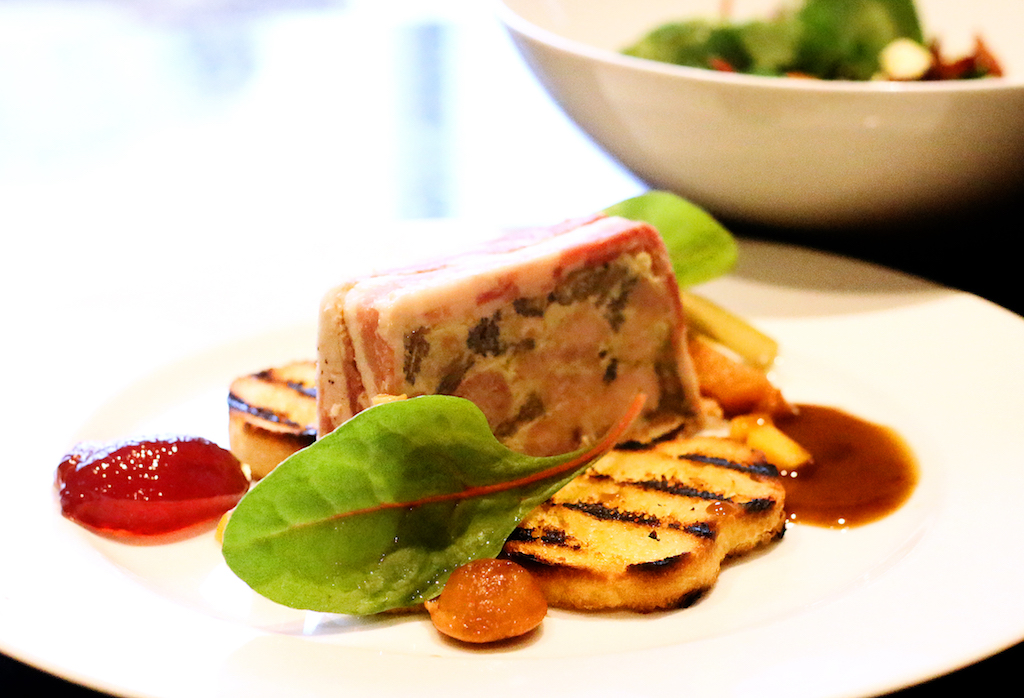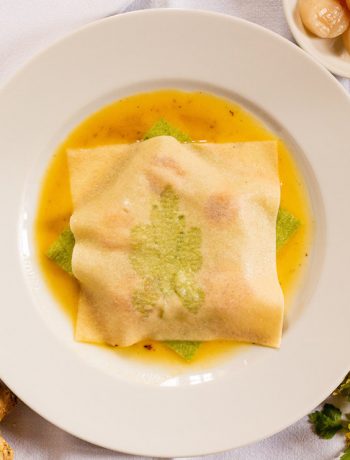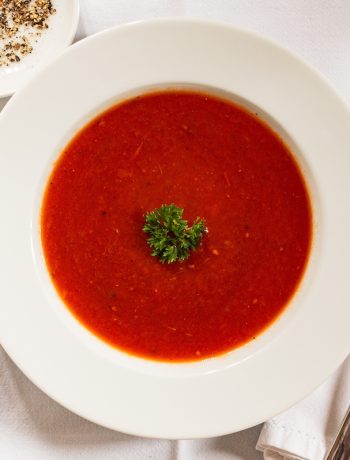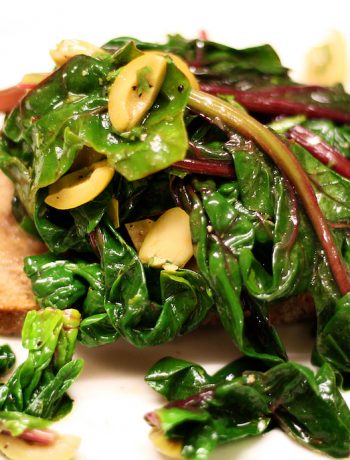This dish was born out of a Nosey Chef kitchen and butchery disaster. Here is how it came about:
La Tante Claire was a three-Michelin star restaurant run by Pierre Koffmann. It was in the same building on Royal Hospital Road, London that is now occupied by the three-starred Restaurant Gordon Ramsay. While at La Tante Claire, Koffmann came up with a recipe of pigs trotters stuffed with a chicken mousseline.

Pierre Koffmann (1948–). Former owner of La Tante Claire
Koffmann protégé Marco Pierre White took the recipe to Harveys in Wandsworth, where it became the signature dish of the restaurant. White describes the dish as his favourite of all time and writes in White Heat 25:
“This is my favourite dish. If it was a painting it would hang in the Tate. It’s simple, and earthy, but it’s also intelligent. You can’t take it any further. It’s a complete meal. It’s not a recipe for talking about; it’s a meal to be eaten.”
With Harvey’s long gone, and Pierre Hoffmann retreating into the comfort of Gascony cuisine, the only way I was going to be able to eat this classic milestone in British restaurant food would be if I made it. The recipe in White Heat is quite lengthy, but broken down, you need to make a sausage and its filling, you need to make a sauce, and you ought to make a nice mashed potato side. The filling is veal sweetbreads and morels bound together with chicken mousse. The sausage skin is skin recovered from the foot of a pig, and the sauce is a classic French sauce of mushrooms and booze, finished with butter and a spot of cream.
The problem for me turned out to be the trotters. In the UK, most pig trotters are triaged either to Chinese cooks, or into jelly making for pork pies. The Koffmann recipe calls for hind trotters with most of the shin attached, and this is where the whole idea starts to unravel. In order to stuff the trotters with the sweetbread and mushroom mixture, you have to have completely unblemished skin. The slightest nick or scratch will cause the skin to open up in a gaping maw when cooked, leaving them completely useless for their intended purpose. I was only able to obtain front trotters with a small bit of shin because most pigs are hung from their hind Achilles’ tendon for butchery, which puts an enormous hole in the back feet.
The first attempt at the dish resulted in the trotter braise going dry in the oven, which stuck the feet to the pan. For the second attempt, I ended up with trotters that had been cut through the ankle and pared back, so they were deemed unsuitable and frozen for some other purpose another day. On Attempt #3, the skins opened up in the cooking liquor and ended up in the bin. However, during that final stab, I had defrosted my pre-made filling. As the filling cost £60 in ingredients, it had to be used for something. So I hit on the idea of making a terrine for a cold starter. This is what I did …
Veal sweetbread and morel terrine
Ingredients
- For the chicken mousse:
- 200g skinless chicken breast, sinew removed and diced
- 1 pinch of mace
- 1 tbsp tarragon, chopped
- 1 egg
- 2 tsp salt
- 225ml double cream
- For the filling:
- 40g dried morels
- 650g veal sweetbreads
- Half an onion, diced
- Olive oil
- For the terrine:
- 300g smoked streaky bacon
Instructions
Make a chicken mousse. Blitz the chicken in a blender for 1 minute with the tarragon and mace. Add the egg and 2 tsp salt, and work for another minute in the blender. Chill the mixture for 15 minutes before adding the cream. Mix thoroughly, and then pass the mixture through a chinois (this will take quite a while, so put the radio on while you do it). Chill until you have the rest of the filling prepped.
Now make the rest of the filling. Soak the morels in cold water for 10 minutes. Drain and rinse.
Remove the sinew and membranes from the sweetbreads. Cube the sweetbreads and fry then in hot oil over a high heat until browned and crunchy.
Add the soaked morels and the diced onion, cook for 1 minute, season, and drain in a colander. Cool the mixture before adding just enough chicken mousse to bind it together. Adjust seasoning. The mixture can now be chilled, or even frozen before use.
Heat an oven to 200˚C.
Line a small loaf tin with the streaky bacon, making sure it overlaps neatly and hangs over the edge of the tin. Pack the lined tin with the filling, and fold the bacon strips over the top.
Place the tin in a bain marie filled to halfway up the sides of the loaf tin. Bake in the oven until the centre of the terrine reaches 74˚C (about 30 mins; use a digital thermometer probe to check).
Remove the loaf tin from the oven and place in a shallow baking tray. Put another identical loaf tin on top and fill with weights (I usually use a load of sockets from an automative socket set; you can also use a brisk wrapped in a dish towel), and leave to cool overnight. Make sure that your pressing rig is not at risk of falling over. It is best to cool and compress the terrine in the fridge, or a cold winter garage.
Once cool and pressed, briefly warm the base of the loaf tin in hot water to release the terrine. Turn the terrine out onto a plate.
Serve sliced with toast, a side salad and some chutney or redcurrant jelly.
Notes
In the picture, I served this as a lunch. I served it with some home-made pickles, ungarnished bruschetta, a persimmon brunoise, rowan and apple jelly, Swiss chard and a drop of the Madeira and morel sauce that was supposed to adorn the trotters. I served it with a side salad of mixed green leaves, French dressing, Peakland white cheese and crispy, smoked bacon bits. Certainly, it needs a fruit chutney, some pickles and a good bread.






1 Comment
Karl Stolpstedt
26/05/2022 at 7:53 amSounds amazing, and doable. Thanks.